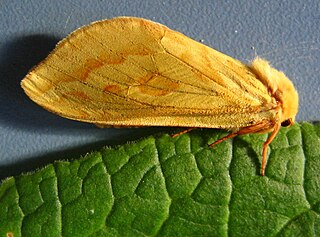
The Hepialidae are a family of insects in the lepidopteran order. Moths of this family are often referred to as swift moths or ghost moths.

The ghost moth or ghost swift is a moth of the family Hepialidae. It is common throughout Europe, except for the far south-east.

The common swift is a moth of the family Hepialidae. It was previously placed in the genus Hepialus. It is a common, often abundant European species. The species was described by Carl Linnaeus in his 1758 10th edition of Systema Naturae.

Hamearis lucina, the Duke of Burgundy, the only member of the genus Hamearis, is a European butterfly in the family Riodinidae. For many years, it was known as the "Duke of Burgundy fritillary", because the adult's chequered pattern is strongly reminiscent of "true" fritillaries of the family Nymphalidae.

The orange swift or orange moth is a moth belonging to the family Hepialidae. The species was first described by Carl Linnaeus in 1761 and was previously placed in the genus Hepialus. It is distributed throughout Europe.

The gold swift is a moth belonging to the family Hepialidae. Until recently it was placed in the genus Hepialus. The species was first described by Carl Linnaeus in his 1758 10th edition of Systema Naturae. Moths of the Hepialidae are considered to be primitive moths; they do not have a proboscis and are unable to feed. The gold swift is a widespread species found in Europe and Asia, including Japan.

The map-winged swift is a moth belonging to the family Hepialidae and has a patchy distribution throughout Eurasia. The species was first described by Charles De Geer in 1778. It was previously placed in the genus Hepialus and some references still place it there.







